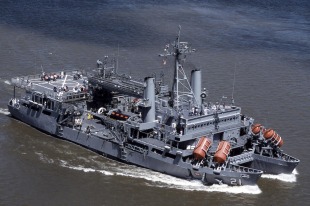Корабель порятунку підводних човнів USS Pigeon (ASR-21)
Класифікація
Основна інформація
Головні розміри
Машина
- 4 * diesel engines
- 2 * shafts
Персонал
Бойові сили та засоби
- 2 * 20 mm guns
- Helicopter platform only
The USS Pigeon (ASR–21) led its class of submarine rescue vessels. Its construction commenced on July 17, 1968, at the Alabama Dry Dock and Shipbuilding Co. in Mobile, Alabama. The ship was launched on August 13, 1969, christened by Mrs. Allen M. Shinn, spouse of Vice Admiral Shinn, Commander Naval Air Force, U.S. Pacific Fleet, and formally commissioned on April 28, 1973. It shared its class with the USS Ortolan (ASR-22).
As the forefront of a novel category of submarine rescue vessels tailored to collaborate with the Navy's fresh deep submergence rescue vehicles, Pigeon became the initial catamaran warship on active sea duty for the Navy since Robert Fulton's twin-hulled steam warship Fulton emerged towards the end of the War of 1812. Its paired hulls offered exceptional stability for deep-water operations and furnished an expansive deck space for work. Pigeon had the capacity to transport two deep submergence vehicles on its primary deck. These vessels could dock with a disabled submarine on the ocean floor, extract survivors, and ferry them to the surface. Additionally, Pigeon housed the McCann diving bell or rescue chamber, akin to the one employed in rescuing the survivors of submarine Squalus (SS-192) in 1939. The vessel's mooring system facilitated precise positioning over a disabled submarine during rescue missions.
Pigeon's rescue command center employed a three-dimensional sonar system for ongoing tracking of the rescue vehicle. During rescue operations, it functioned as a mobile command post, equipped with specialized communication gear to liaise with the disabled submarine and any other vessels, aircraft, or crafts involved in the operation.
Stricken from the Naval Register on August 31, 1992, Pigeon was placed in the National Defense Reserve Fleet, Suisun Bay Group. However, the training necessities at Fleet Training Center San Diego (FTC San Diego) identified a requirement for this vessel. Consequently, it was repossessed by the U.S. Navy on March 23, 2002, and moored at Pier 11, Naval Base San Diego, serving as a non-operational training facility.
Between 2002 and 2005, Pigeon was utilized by the Naval Education and Training Command's Center for Security Forces (CENSECFOR; Master-at-arms) for onshore pier-side anti-terrorism Counter-terrorism/Security forces (AT/SF) training. CENSECFOR developed the educational program for classroom sessions and conducted practical sessions aboard the Pigeon. In October 2004, plans were made to replace Pigeon with a new shore-based hardened training structure for ongoing AT/SF training. A series of coordinated actions were undertaken to transfer Pigeon to the Suisun Bay Reserve Fleet (SBRF).
Finally, Pigeon was towed to Brownsville, Texas, in January 2012 for scrapping.
Interesting fact
In Tom Clancy's novel «The Hunt for Red October,» the USS Pigeon played a pivotal role in rescuing Soviet seamen from the rogue ballistic missile submarine Red October. This occurred after Captain Ramius orchestrated a simulated shipboard emergency. The USS Pigeon and its DSRV (Deep Submergence Rescue Vehicle) were central to this storyline. Additionally, the USS Pigeon and its DSRV were prominently showcased in the 1978 disaster film «Gray Lady Down.»
- Коментарі
 uk
uk en
en ru
ru





 Командування військово-морських перевезень США
Командування військово-морських перевезень США